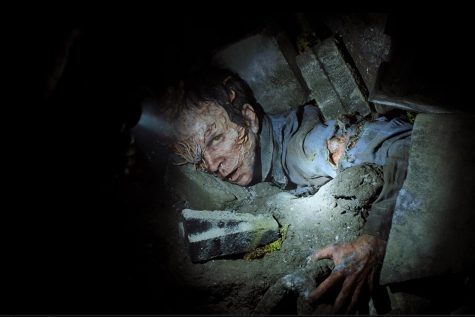“The Last of Us” subverts the typical zombie show
The adaptation’s focus on characterization explores survival in the apocalypse
Ellie’s book of puns serves as comic relief in “The Last of Us,” capturing a glimpse of the original video game’s spirit.
March 26, 2023
In 2013, a mutated strain of Cordyceps triggers a global outbreak, flinging the world into disarray. HBO’s “The Last of Us,” released in nine episodes from Jan. 15 to March 12, faithfully adapts the video game of the same name while building on the source material with a fresh slate of new characters and scenes. The show follows Joel (Pedro Pascal), a smuggler dragged into a road trip across post-apocalyptic America with an unlikely companion, the military school escapee Ellie (Bella Ramsey) who could be the key to saving the world.
Joel and Ellie’s journey begins in Boston, Massachusetts, and ends in Jackson, Wyoming, painting a picture of a familiar world in ruins. Stark color grading and post-apocalyptic scenery are blended to create an immersive environment, complete with a soundtrack that merges dramatic acoustics with nostalgic pre-outbreak hits like Depeche Mode’s “Never Let Me Down Again.” Harrowing fight scenes are framed by handheld camera shots, while old-school effects seamlessly meld fungal growths with human skin, transporting viewers into the fray of Joel and Ellie’s clashes with Cordyceps-infected mutants.

Despite its realistic visual effects, “The Last of Us” dodges oversaturation of gory action sequences, allowing characterization to shine through instead. The simplicity of the central plot puts the spotlight on previously non-playable characters, with a series of flashbacks and added scenes fleshing out their backstories. Lively banter and expressive dialogue bring Joel and Ellie to life, and their dynamic remains the highlight of the series, endearing the show to both fans of the video game and new viewers.
“The Last of Us” also embraces a range of themes, putting an unexpectedly authentic spin on the usual zombie show. The series invokes horror through its grim portrayal of a dysfunctional post-apocalyptic society and an arsenal of unsettling scenes, such as an opening talk show sequence discussing the scientific possibility of a world-ending Cordyceps pandemic. Recurring motifs of family, loss and purpose are woven into a nonlinear timeline, raising the stakes of the central plot and introducing moral complexity to the apocalypse.
However, “The Last of Us” discards the bulk of its subplots within episodes, and though brutal death scenes are among the show’s most poignant moments, a flagrant disregard for supporting characters’ lives stifles the emotional mark made on the audience. Background characters become overdeveloped plot devices, while a mix and match of lengthy flashbacks and verbatim ripoffs of video game cutscenes contribute to jarring pacing, flat interactions and an abrupt and unimaginative season finale.
Despite falling short in later episodes, “The Last of Us” ultimately cements itself as a uniquely character-driven rework of the classic zombie apocalypse narrative. Joel and Ellie’s story hits home across nine episodes packed with rewarding character development, immersive settings and parasitic fungus chaos, entertaining fans of the video game and leaving newer audiences hungry for more.
Rating: 3.5/5


















